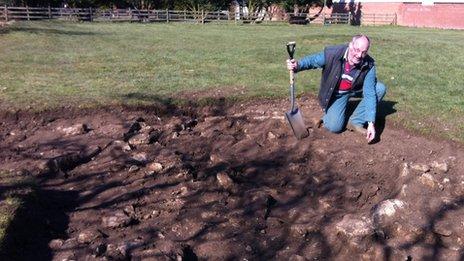Navenby dig starts to uncover Roman town
- Published

Project leader Ian Cox said an earlier excavation, which found the remains of a large building, was being opened up before new work began
Work has started on a £110,000 dig to uncover evidence of a Roman town which lies beneath a Lincolnshire village.
Archaeologists said the excavation, in Navenby, could help them trace Roman occupation in the area from AD55.
A small dig in 2009 found remains from the 3rd and 4th centuries AD but experts believe it could go back to the earliest phase of the invasion.
The project, which started this week, has been part-funded by a £54,800 Heritage Lottery Fund grant.
Evidence of an ancient settlement at Navenby had been suspected for decades but substantial remains were discovered in the 1990s when the land was being developed for housing.
Volunteer group
The developer donated the site to North Kesteven District Council.
The Navenby Archaeology Group, which was set up in 2000 to monitor discoveries on the site, applied for the lottery money and is match-funding the latest work.
Initially archaeologists believed the remains could have been a Roman service station, providing food for travellers on Ermine Street, the road between London and York.
But the dig in 2009 revealed evidence of a Roman town, with up to 300 houses, shops and a blacksmith.
Project leader Ian Cox said: "We did a geophysics of the area and found some very interesting signs, we then did the exploration which we are uncovering at the moment.
"The remains we have found are perhaps the 3rd or 4th centuries, which is really the later stages of the Romans being in the country.
"But we are hopeful we can get down to find if there is something earlier."